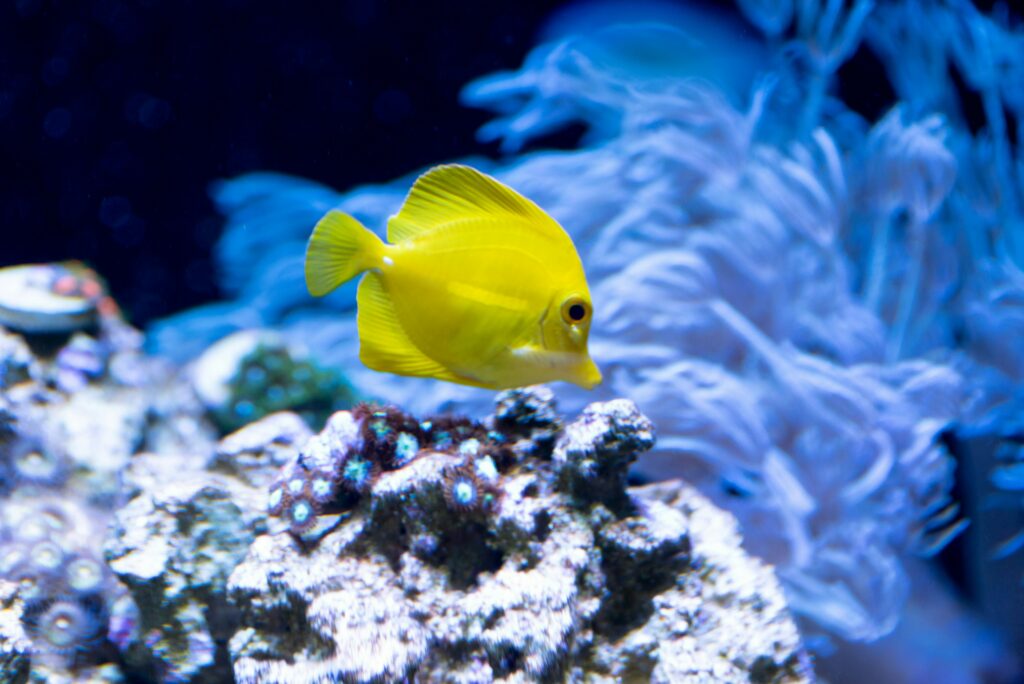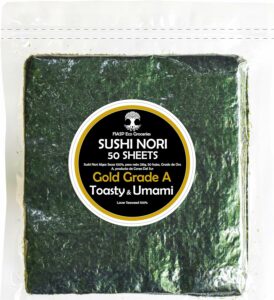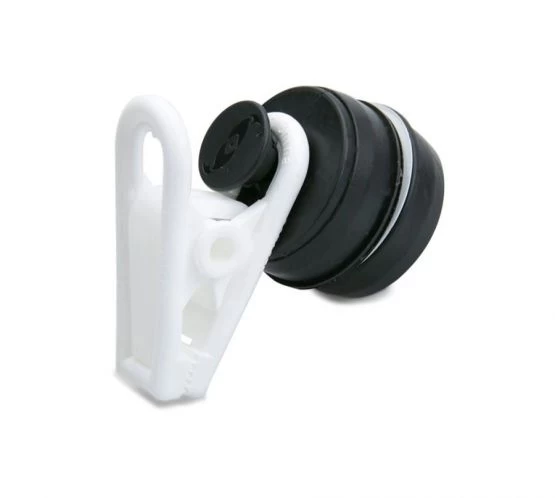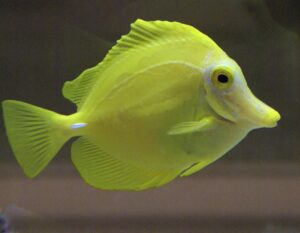
Fish Profile
Yellow tangs (Zebrasoma Flavescens) are popular marine fish that are known for their bright yellow colour and triangular body shape. They are native to the reefs of the central Pacific Ocean, including the Hawaiian Islands.
Tangs are typically peaceful fish and can get along well with other species, but they can be aggressive towards other tangs of the same species, especially when it comes to claiming territory and defending algae. Yellow Tangs have been known to attack the Copperband Butterfly Fish.
This species is considered hardy and relatively easy to care for, but they do require a large tank capacity with plenty of open swimming space and regular feeding.
Quick Facts
Here are some quick facts about Yellow Tangs
- Scientific Name: Zebrasoma flavescens
- Family: Acanthuridae
- Origin: Central and South Pacific
- Reef safe: Yes
- Care: Easy / Moderate
- Diet: Algae
- Maximum size: 8 inches
- Minimum tank size: 70 gallons
- Recommended temperature: 24-26 degrees Celsius
Yellow Tang Diet
In a marine tank, a yellow tang’s diet should consist primarily of marine algae. Yellow tangs are herbivorous fish, so they should be fed a diet that is rich in algae, spirulina, and other plant-based foods.

Nori Sushi Sheets
The most popular food for Yellow Tangs is called Nori Sushi Sheets which you can buy online or in your local supermarket.
Yellow tangs should never run out of algae, this is their primary food source and should be made available at all times to promote health and prevent aggression.
It is also a good idea to supplement the Yellow Tang diet with occasional feedings of live or frozen brine shrimp, Mysis shrimp, or other small meaty foods. It is important to provide a varied diet to ensure that the tangs receive all of the nutrients they need to maintain good health.
Feeding Tips for Yellow Tangs
Use a seaweed clip to secure vegetable supplements such as Nori Sushi sheets.
The best seaweed clip is the Veggiemag which uses a magnet to secure itself to the inside of your aquarium holding the seaweed in place – perfect for tangs to graze on.
These magnet seaweed clips are expensive but do keep the Nori stuck well to the glass, unlike a lot of other suction clips that are prone to detach and fall off.

Tank Mate Compatibility
Yellow tangs are generally peaceful fish and can get along well with other species in a marine tank. They are typically compatible with other peaceful fish, such as clownfish, damselfish, dwarf flame angles, and wrasses, as well as with invertebrates like crabs, cleaner shrimp, and snails.
However, yellow tangs can be aggressive towards other tangs of the same species, especially when it comes to claiming territory, so it is best to avoid keeping multiple yellow tangs in the same tank.
Tang Compatibility Chart
| Fish Species | Common Name | Compatibility Notes |
|---|---|---|
| Paracanthurus hepatus | Blue Reagle Tang | Peaceful; ensure ample space as both species are active. |
| Amphiprion ocellaris | Clownfish | Peaceful and reef safe; good with most tangs. |
| Centropyge bispinosa | Coral Beauty Angelfish | Generally peaceful; watch for territorial disputes. |
| Ecsenius bicolor | Bicolor Blenny | Reef safe and peaceful; provides algae control. |
| Pseudochromis fridmani | Orchid Dottyback | Peaceful with similar size fish; adds colour variety. |
| Gobiodon okinawae | Yellow Clown Goby | Peaceful and small; good for adding diversity. |
| Synchiropus splendidus | Mandarinfish | Peaceful; requires specialised care for diet. |
| Salarias fasciatus | Lawnmower Blenny | Excellent algae eater; peaceful and reef safe. |
| Labroides dimidiatus | Cleaner Wrasse | Beneficial for fish health; peaceful and reef compatible. |
| Gramma loreto | Royal Gramma | Peaceful and vibrant; a colorful addition that’s reef safe. |
If you have problems with aggressive yellow Hawaiian tangs then read our top tips on preventing yellow tang aggression at the bottom of this page.
Common Diseases
Yellow tangs, like all fish, can be susceptible to a variety of diseases. Some common diseases that can affect yellow tangs in captivity include marine ich (also known as white spot disease), marine velvet disease, and fin rot.
Fish keepers need to monitor their yellow Hawaiian tang carefully and look for signs of disease, such as changes in behaviour, appetite, or appearance. Regular water testing and maintenance of the aquarium environment can also help prevent the development of diseases in yellow tangs and other fish.
Always quarantine new fish for at least 2-4 weeks before introducing them to the main tank to prevent the spread of diseases.
Common Yellow Tang Names
Some other common names for the yellow tang include:
- yellow sailfin tang
- yellow doctorfish
- yellow Hawaiian tang
- yellow Surgeonfish
In scientific literature, the yellow tang is often referred to by its scientific name, Zebrasoma flavescens.
Tips for dealing with aggression
Here are some tips to help prevent aggression among yellow tangs in a marine tank:
- Keep only one fish of this species per tank, or provide plenty of hiding places using live rock and territories for them to claim.
- Make sure the tank is not too small or crowded, and provide plenty of open swimming space and hiding places for all of the fish.
- Carefully select and introduce new fish to the tank, and monitor their behaviour to ensure that they are getting along well.
- Avoid overstocking the tank, as this can increase the likelihood of aggression and fighting among the fish.
- Provide a varied diet that is rich in marine algae and other plant matter, and supplement with occasional feedings of live or frozen meaty foods.
- Monitor the water quality regularly, and perform regular water changes and maintenance of the filtration system to keep the water clean and well-oxygenated.
- Avoid exposing the fish to sudden changes in temperature, pH, or other water parameters, as this can stress the fish and increase the likelihood of aggression.
- When adding new fish try temporarily positioning mirrors close to your marine tank – this has been known to distract an aggressive tang.

Breeding Yellow Tangs
It is not common for yellow tangs to breed in captivity. Yellow tangs are pelagic spawners, which means they release their eggs and sperm into the open water to fertilise. In the wild, this occurs during the full moon, when the water is at its warmest and most turbulent.
In captivity, yellow tangs may not have the right environmental conditions or triggers to initiate breeding behaviour. This means yellow tangs are not commonly available for purchase and are wild-caught. However, recently the Oceanic Institute at Hawaii Pacific University had a breakthrough where they bred aqua-cultured yellow tangs, which can be purchased online.
Frequently Asked Questions
Are yellow tangs reef safe?
Yes, Yellow Tangs are reef safe. They are a popular choice for reef aquariums due to their peaceful nature and compatibility with corals and other invertebrates.
How big do yellow tangs get?
Hawaiian tangs typically grow to about 20 centimetres (8 inches) in captivity. It’s important to provide them with ample space as they mature.
How fast do yellow tangs grow?
Tangs grow at a moderate rate, reaching full size in approximately 2 to 3 years under optimal aquarium conditions. Growth rate can vary based on diet, tank size, and overall health.
How long do yellow tangs live?
The lifespan of a yellow tang in captivity is typically between 10 and 15 years. However, the actual lifespan of a yellow tang in captivity will depend on a variety of factors, including the quality of its care, its diet, and its overall health.
With proper care and a healthy diet, a yellow tang can live for many years in a well-maintained marine tank.
In the wild, yellow tangs can live for even longer, with some individuals reaching 20 years or more.
In captivity, tangs may face many challenges that can impact their lifespan, including poor water quality, inadequate diet, and aggression from other fish.
How many yellow tangs in one tank?
For Golden Sailfin Tangs, it’s recommended to keep just one per tank to prevent territorial disputes, especially in smaller setups. For larger tanks, you might consider more, but ensure ample space for each to establish its territory.
Here are some tank-size examples:
Up to 200 litres (44 UK gallons) is suitable for one Golden Sailfin Tang.
400 to 600 litres (88 to 132 UK gallons) you could potentially house two, given the tank has adequate hiding spots and space.
Over 600 litres (132 UK gallons) larger groups may be possible, but careful observation and management are crucial to mitigate aggression.
Always consider the mature size of the fish and the complexity of your tank’s environment when planning its inhabitants.